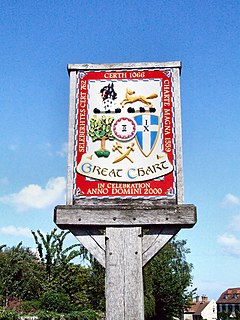Great Chart
| Great Chart | |
|---|---|
 Great Chart village sign |
|
| Great Chart shown within Kent | |
| Area | 13.31 km2 (5.14 sq mi) |
| Population | 6,801 (Civil Parish) |
| • Density | 511/km2 (1,320/sq mi) |
| OS grid reference | TQ983422 |
| Civil parish | |
| District | |
| Shire county | |
| Region | |
| Country | England |
| Sovereign state | United Kingdom |
| Post town | Ashford |
| Postcode district | TN23 |
| Dialling code | 01233 |
| Police | Kent |
| Fire | Kent |
| Ambulance | South East Coast |
| EU Parliament | South East England |
| UK Parliament | |
Great Chart is a village in the civil parish of Great Chart with Singleton in the Ashford Borough of Kent, England. The parish is split between the ancient village of Great Chart and the modern Singleton neighbourhood on the western outskirts of Ashford. The village centre of Great Chart is 2 miles (3.2 km) from the town centre.
Great Chart is first mentioned in 762 as Seleberhtes Cert, a Jutish name. It is also known that at this year, the village was operating a mechanical water mill, the first water mill to be recorded in Britain. A charter first mentions Seleberhtes Cert when recording that King Ethelberht II (of Kent) exchanged half the use of the successfully operating mill for some pasture in the Weald.
In 776 Great Chart's manor, the village, its lands and much of its produce were sold by King Egbert (Ethelberht's successor) to Archbishop Jænberht of Canterbury to raise finances for a Kentish army - to rebel against King Offa of Mercia. In that year there was a great battle between Mercians and Kentish men at Otford as, apparently, a red cross appeared in the sky.
For nine years after this battle Egbert held Kent, but ultimately Offa took control and retrieved Great Chart and its lands from Canterbury dividing them up among his followers. After Offa died in 796 his successor Coenwulf of Mercia decided to reinstate properties, including Great Chart, back to the ownership of Canterbury. This ownership continued for hundreds of years through the Norman Conquest - the Domesday Book entry for Certh (Great Chart) makes clear that it was still in the possession of the Archbishop of Canterbury and had two mills, a salt-pit, feeding ground for a hundred hogs, and a population of fifty-two - up to the advent of Henry VIII when between 1536 and 1539 he dissolved all monasteries. He confiscated Great Chart and its lands from the priory but soon reinstated them to his new Protestant Dean and Chapter in whose administration they remained until Victorian times (though in a map of the area from 1621 the lands are still attributed to 'Christ Churche', referring to Christ Church in Canterbury). On a map made of the Chart and Longbridge Hundred in 1559, the village was named Charte Magna.
...
Wikipedia

